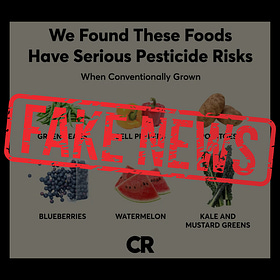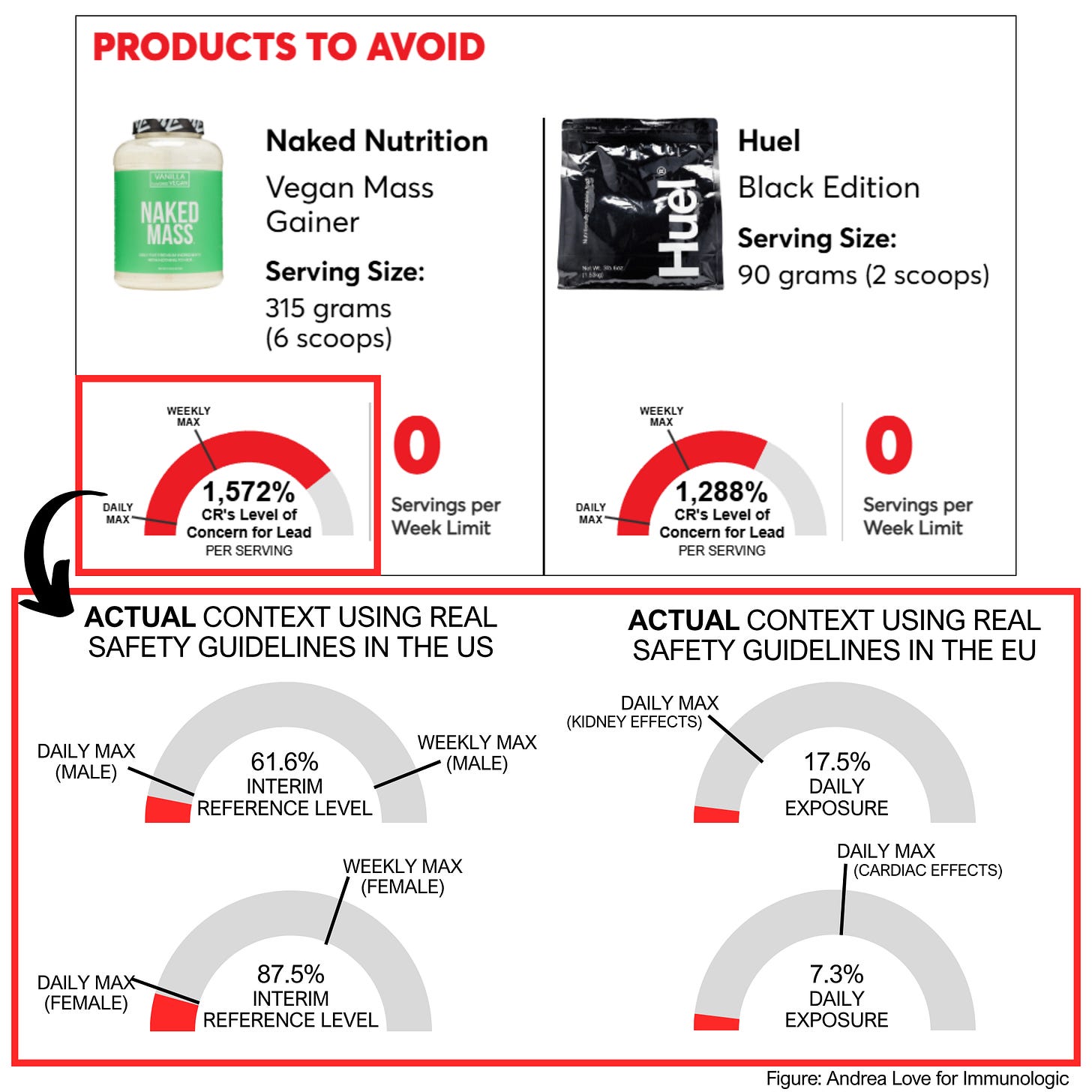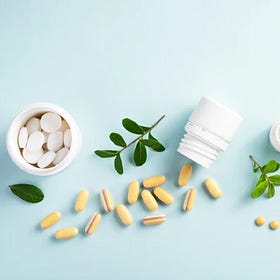Consumer Reports’ Latest Panic: “Toxic” Lead in Protein Powders
Lead exposure from protein powder is far below safety thresholds. Chemophobia and the supplement industry’s lack of oversight are the real dangers.
This newsletter is free, but consider supporting a biomedical scientist trying to combat the war on health by upgrading to a paid subscription:
Consumer Reports is at it again, this time, fear-mongering about lead in protein powders. Their latest headline and “report” concludes that various protein powders are filled with harmful levels of lead, and they use scary-looking graphics with percentages above 1000, to evoke that health anxiety they are so good at.
The big takeaways:
No, you don’t need to panic about lead in protein powder — certainly based on their information
and
Yes, we need regulatory oversight of dietary supplements — which means we need to get rid of the 1994 Dietary Supplement Health and Education Act to enforce safety (and benefit) of dietary supplements.
Two things can exist at once.
I have zero skin in the game when it comes to protein powders — I don’t take them and there isn’t compelling data they benefit most adults. I do have a lot of concerns about the wildly lucrative, wildly unregulated, and exponentially growing dietary supplement industry, which protein powders are part of.
But the issue with this “report”:
The lead levels Consumer Reports published are not above safety guidance for food items, dietary supplements, and daily intake levels and
Consumer Reports has a long history of spreading chemophobia, disinformation, and fearmongering for their personal benefit.
They love to self-define levels of a given “exposure” they think are bad as a way to disregard scientifically-grounded guidelines they choose to ignore. I wrote about this tactic when they told people safe and nutritious fruits and vegetables had “serious pesticide risks”—they don’t. Consumer Reports just made up random numbers to scare people away from healthy foods:
No, conventional produce doesn't have "serious pesticide risks"
Consumer Reports is manipulating data and lying to consumers to propagate chemophobia. Headlines about harmful pesticides in conventional foods are lying to you in order to create fear.
Consumer Reports is an activist group. They are not a scientific organization. They lobby extensively to push policies that serve their donors interests. Recently? They sponsored the “food dye ban” in California and the “ultra-processed food ban” (also in California), neither of which are based on credible science.
They LOVE to push bad toxicology with scary health claims.
Another example: Dr Michelle Wong, one of the only science communicators that I trust without fail to provide accurate analysis of topics she covers, wrote a piece on their “toxic hair extension study” earlier this year.
Anyway, let’s dig in.
Proposition 65 Maximum Allowable Dose Levels (MADL) for Lead Are Not Based on Science.
Consumer Reports states that lead found in protein powders tested exceed “CR’s Level of Concern for Lead” — which is why they are sounding the alarm. So, what that level is based on, right?
Well, it’s based on Proposition 65. Consumer Reports claims they use Prop 65 levels because those standards are “the most protective of health” — which is false. They use those because they are the most strict, even if they aren’t based on actual data.
Proposition 65 is political legislation pretending to be science.
California Proposition 65 (Safe Drinking Water and Toxic Enforcement Act of 1986) requires warning labels about chemicals in consumer products that have some sort of association to cancer, birth defects, or reproductive issues. Sounds good in theory, right? The problem? Prop 65 is based on the precautionary principle.
The precautionary principle asks: “is there ANY situation in ANY hypothetical scenario that this substance could cause potential harm?”
and not “is there ANY realistic risk to humans based on the exposure range of this substance over a single exposure or throughout the course of one’s life?”
If this sounds familiar, it should. It’s a similar approach as the WHO’s IARC “carcinogenicity” hazard assessments.
Prop 65 states that if there is a hypothetical world in which exposure to a chemical might contribute to 1 additional case of cancer per 100,000 people occurs over a 70-year lifetime, the chemical would be added to the list. Cancers are complex multifactorial diseases, so this criterion is excessively stringent when 1 additional case of cancer over 70 years could happen due to pure randomness.
This law was passed not after consultation with scientific expert agencies, but by a popular vote in the State of California. Most credible scientific experts agree it is not aligned with scientific consensus data.
Lead absolutely poses a health risk—but not at the levels Prop 65 says.
Repeat after me: the dose makes the poison. That’s true for lead, too.
The MADL for lead outlined by Proposition 65 is 0.5 µg of lead per day. This value was set, arbitrarily in 1989, even though scientific evidence continues to show that it’s wildly unrealistic and not remotely near an exposure that would be a health concern. It remains unchanged because Prop 65 is a political tool, not a scientific one.
Consumer Reports decides to ignore FDA interim reference levels for lead in their assessment. These levels are 8.8 µg per day for reproductive age females and 12.5 µg for general adults, 17.6-times and 25-times higher daily exposure levels compared to the Prop 65 levels, respectively, and are already extremely conservative (more on how those are calculated in a moment).
Consumer Reports claims products they tested exceed their “level of concern” (that’s the 0.5 µg/day exposure based on zero science) by thousands of percentage points! Sound the alarm, right? Wrong.
Now, putting aside the flawed methodology, and the absence of raw data including reference and control values, let’s assume the lead levels they published are real for argument’s sake.
The protein powder with the highest reported lead level had a measured value of 7.7 µg for a single serving (Naked Vegan Mass Gainer).
I’m not a protein powder expert, but by the looks of the serving size and the normalized parts per billion (that’s mass of the measured substance relative to total mass of the sample), it appears this powder is not meant for daily/routine consumption.
Regardless, Consumer Reports tells its readers to not consume any of it, because the lead levels are 1,572 PERCENT HIGHER than “CR’s Level of Concern.”
But is it actually a level of concern when it comes to legitimate science and health? No. Using the FDA’s Interim Reference Levels, that protein powder, 6 whopping scoops (that seems excessive for a serving, doesn’t it?), is 61.6% of the reference value for males and 87.5% of the reference value for females. Sounds less scary when you use real scientific guidance, right?
The European approach to lead exposure uses a value called a benchmark dose lower confidence limit (BMDL01). This is a daily exposure level that above which can increase risk of adverse events by 1%. Levels are defined by health outcome and normalized to weight.
For example, cardiovascular effects of lead are defined by a BMDL01 of 1.5 µg/kg body weight/day, and kidney effects are defined by a BMDL01 of 0.63 µg/kg/day. So for the same 70 kg adult Consumer Reports assumes in their report, that would be 105 µg/day, for cardiac concerns—210X higher than the Prop 65 level, and 44 µg/day for kidney concerns—88X higher than the Prop 65 level.
The EU actually regulates dietary supplements. Their regulatory threshold for lead in supplements is 3,000 parts per billion—123X higher than measured levels in these protein supplements.
The highest measured level reported by Consumer Reports are well below European and US safety guidance for lead exposure through food products. That should give you some peace of mind.
Then you have their flawed methodology. They tested 2 or 3 samples each of 23 commercial products bought at select grocery stores in New York and online from November 2024 through January 2025. They took these and sent them for analytical chemistry assessment at a third-party lab.
That is not a robust methodology by any stretch of the imagination. Given they have not provided individual values of each of the “2 or 3 samples” per brand or the control values, I’m not going to dwell on this. The main point: these levels of lead are not those that cause harm.
But there’s no safe level of lead! Except—you have lead in your body at all times.
You’ve probably heard the phrase “there’s no safe level of lead” as a reason for why people should be more fearful of these miniscule levels of lead, right? Yes, it technically true, but that doesn’t also mean that every single exposure to lead is automatically dangerous.
Lead is everywhere on our planet — it is literally an element of the Earth. It is found naturally in soil, dust, air, and even food. Every single person has measurable lead in their bodies (in blood). In the US, adults typically have lead blood levels around 0.5-1.5 µg/dL, a 90% reduction compared to blood levels of lead in the 1970s, thanks to unleaded paint and gasoline! Why aren’t we talking about that more?
That baseline blood lead level (BLL) doesn’t mean all of us are being poisoned—it should help you understand that zero exposure is literally impossible. So let’s use context and data to make our decisions, right?
Adverse health effects attributed to lead exposure in adults are not seen until blood lead levels reach 10–20 µg/dL.
When safety thresholds are set for foods, environment, water by legitimate scientific experts—they do this very math: what exposure of lead will lead to elevated blood levels of lead that pose this health risk?
Consumer Reports does not. Proposition 65 does not.
The interim reference levels (IRL) of 8.8 µg/day (women of childbearing age) and 12.5 µg/day (general adults) are based on how lead exposure alters blood lead levels (BLL).
The IRL, set in 2018, represented a decrease from the previous daily exposure level of 75 µg/day. More than that, the IRL for women of childbearing age (WOCBA) was updated in 2022 from the general adult level of 12.5— not for the adult, but for a potential fetus.
A daily exposure level of lead of 12.5 µg equals a blood lead level of 0.5 µg/dL.
For WOCBA, a daily exposure of 8.8 µg corresponds to 0.35 µg/dL, which aligns with pediatric IRL of 2.2 µg/day (0.35 µg/dL BLL).
You can see how conservative even the IRL is, given most adults walk around with roughly 1.0 µg/dL BLL and this moves the needle 0.5 µg/dL, but health effects aren’t observed until BLL exceed 10 times that. The IRL includes a 10-fold safety factor relative to the lowest effect levels (LOELs) recorded for human health intentionally.
When discussing lead exposure and what’s “safe” in foods, water, etc., the reality of the world must also be considered.
Food products, tampons, water inevitably have trace levels of lead in them (because crops grow in the environment) — the IRLs are set very conservatively to prioritize safe products and ensure blood lead levels aren’t going to lead to health issues.
We cannot avoid lead—it is everywhere. So we use science-based safety guidance to minimize our real risk, not propagate fear based on chemophobia and disinformation, which is exactly what Proposition 65 and Consumer Reports is doing.
Ironically, it was also the same rhetoric that appears in the “toxic lead in tampons” study last summer, which I also wrote about:
Harmful Levels of Lead in Tampons?! Not so fast...
Another day, another wildly mischaracterized paper going viral online, eroding science literacy, exacerbating chemophobia, and making our jobs as scientists harder.
No, your protein powder isn’t poisoning you—but the supplement industry SHOULD be regulated.
Consumer Reports propagates chemophobia and disinformation and shouldn’t be used as a reference for anything remotely related to health. Chemophobia isn’t just bad science—it distracts from the real problem: protein powders are part of a supplement market that’s untested, unregulated, and perfectly legal to sell you whatever’s in the tub.
Why aren’t supplements regulated? That’s thanks to the 1994 Dietary Supplement Health and Education Act—more political legislation wrapped up as “health freedom.”
That means there is:
No pre-market safety testing. Supplement companies can sell a new product tomorrow with zero FDA review.
No efficacy data required. They can make vague “supports wellness” claims without ever proving they do anything.
No consistent contaminant standards. Unless a product is proven to cause harm, the FDA has no power to pull it from shelves.
There are no enforced standards for quality control, raw material sourcing (ingredients), manufacturing, or contamination (microbial and other).
This isn’t a small market. The dietary supplement industry is a $159 billion dollar economy in the US — and it is the modern Wild West.
Over 80,000 supplement products on the shelves are unvetted before you buy them: a serious regulatory gap given nearly 75% of adults report taking supplements.
There are well-documented harms due to unregulated supplements. Over 23,000 emergency department visits every year are linked to supplement harms, likely an underestimate. Increasing rates of acute liver toxicity driven by “greens” supplements and herbal mixtures. Medicine interactions or exacerbation of medical conditions (supplement is not a synonym for safe), and real contamination concerns.
Unlike prescription drugs, over-the-counter medicines that are FDA-approved or even fortified foods, supplement manufacturers aren’t required to submit ingredient specs, contaminant data, or post-market safety reports. Supplements have been routinely found to not disclose what’s actually in them.
This—the unregulated supplement and wellness industry—is the legitimate concern we should be discussing, not lead levels that aren’t actually above safety thresholds.
I’ve written a lot about this topic, start here:
Dietary Supplements are not regulated for quality, safety, or efficacy
In the United States alone, the dietary supplement industry is currently valued at $159 BILLION dollars and projected to grow by 9.1% year over year.
The Consumer Reports data with wildly different lead levels between brands (assuming, generously, their data are accurate) likely reflects quality differences in sourcing, manufacturing, and quality control. It’s entirely plausible that some companies are cutting corners — sourcing lower-quality ingredients, skipping contaminant remediation, or manufacturing in facilities without proper oversight.
Others may be implementing good quality control and manufacturing practices. We don’t know because there is no oversight. That’s what happens when an industry is driven by greed and pseudoscience, facilitated by political legislation.
Consumer Reports is not providing oversight with shoddy methodology of buying a few boxes here and there and testing a couple of replicates—that is not how quality is assessed. Trust me, I know—we do it every day at my real job.
If you were alarmed by these headlines, be alarmed for the right reasons.
The takeaway shouldn’t be “panic about trace metals.” It’s should be: “the supplement industry is long overdue for regulation.” And that’s even more true with wellness influencers taking over our health agencies.
We should be demanding repeal or reform of the 1994 DSHEA to require:
Pre-market safety testing and ingredient registration
Mandatory third-party contaminant testing
Real post-market surveillance and recall authority
That’s how we protect the public. Not through chemophobic headlines, clickbait, or arbitrary Prop 65 fearmongering, but through robust science, real transparency, and actual public health oversight.
We all must join in the fight for science.
Thank you for supporting evidence-based science communication. With outbreaks of preventable diseases, refusal of evidence-based medical interventions, propagation of pseudoscience by prominent public “personalities”, it’s needed now more than ever.
Stay skeptical,
Andrea
ImmunoLogic is written by Dr. Andrea Love, PhD - immunologist and microbiologist. She works full-time in life sciences biotech and has a lifelong passion for closing the science literacy gap and combating pseudoscience and health misinformation. Follow on Instagram, Threads, Twitter, and Facebook, or support the newsletter by subscribing:








Thank you! Your Substacks on chemophobia and fear based information are very helpful. I went down a rabbit hole when I read, a few years back, that dark chocolate is high in metals. I just googled it and it was put out my CRs.
My husband just asked about lead in protein powders over breakfast this morning. I read this yesterday and pulled out my cell phone 😌 thank you!!